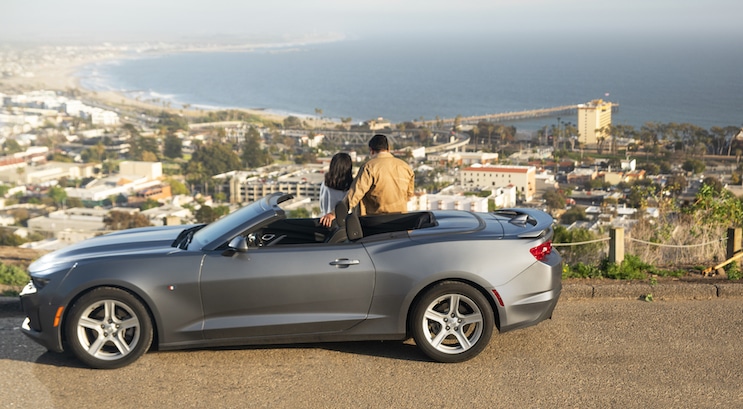
The Ventura Highway and the Pacific Coast Highway are one in the same from Camarillo north through Ventura. Many scenic outlooks overlooking the coastal cities offer spectacular views. Photo courtesy of Visit Ventura Coast Country
And with the receding specter of COVID still looming, there’s more than enough reason to travel in a socially distanced environment that allows flexible family vacations.
Road trips became increasingly popular over the past two years, and the conversion of 50s and 60s motels into retro sleep stops has responded to the need for more accommodations as travelers hit the roads instead of the skies. While the term “rubber wheeler” has come into vogue as an unfortunate substitute for the more refined “road trip destination,” it does aptly reference this popular form of travel: the road trip and the reason why car advertising of the 50s touted it so extensively.
We can thank the Eisenhower administration for the Federal-Aid Highway Act of 1956 which gave rise to the crisscross of interstates that help us easily traverse the country. And we now have SUVs and RVs loaded with safety features to replace the humongous, gas-guzzling station wagons and V8 vehicles that lumbered along oftentimes unpaved and unsafe roads.
Today, traditional gas-powered vehicles are more efficient than ever and the increasing number of electric and hybrid cars reduce operating costs even more. Yes, inflation means you’ll spend more on gasoline, but a trip planned in advance with helpful information from the American Automobile Association (AAA) can still be an affordable vacation.
So, the short of all this: road trips continue to make sense. Push those images of Rat Race or Thelma and Louise aside, kick off your playlist with “On the Road Again,” and take a look at these three diverse itineraries.
California’s Ventura County Coast
Camarillo to Ventura
There’s something about road trips that inspires songs to glorify them. The band America has been singing about Ventura Highway since 1972. Even if you aren’t a child of the era, you probably know the lyrics, “Ventura Highway in the sunshine, where the days are longer, the nights are stronger than moonshine. You’re gonna go, I know.” If ever there was an ode to road tripping, this is certainly it.
If arriving at LAX, Ventura Highway is a short sprint north on the 405 Santa Monica Freeway. After crossing the Santa Monica Mountains and heading down into the San Fernando Valley, merge onto the 101 Ventura Highway heading west. Follow the 101 through the Valley until it drops down to the coast at Camarillo. From there you’ll enter a landscape defined by agricultural and foodie attractions, surfing culture, funky towns and even a national park.
Camarillo
Surrounded by the Santa Rosa foothills, Camarillo is all about the farm-to-table lifestyle. The city was originally a 10,000-acre ranch. There’s some gorgeous Victorian architecture here like the stunning Camarillo Ranch House. Kids will love the Commemorative Air Force museum. But it’s agritourism that’s the big draw.
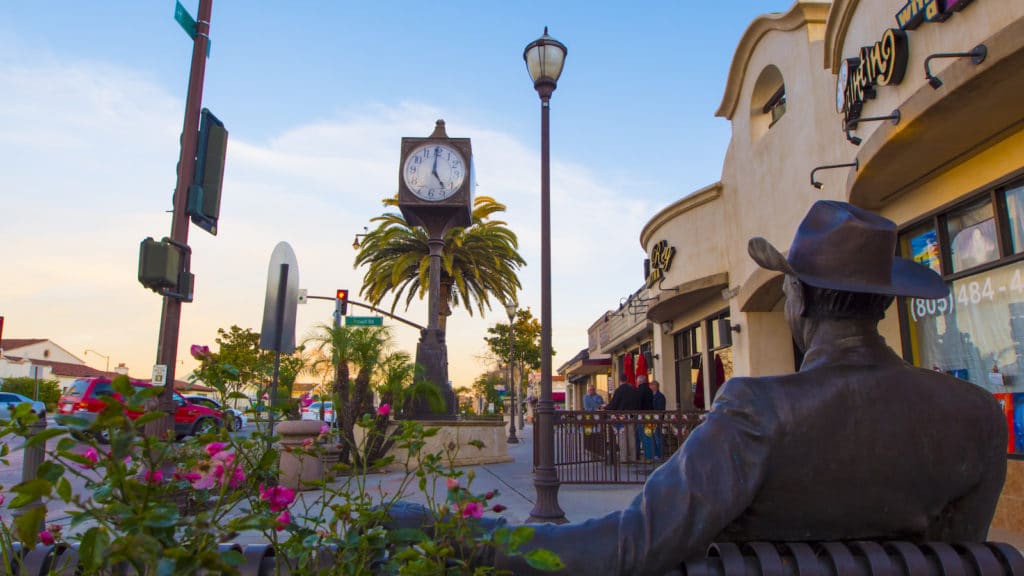
Old Town Camarillo on the western edge of the San Fernando Valley has lost much of its citrus but retained most of its charm.
Part of Camarillo’s Farm Trail, family-owned Gerry Ranch invites you to pick your own blueberries, avocados and lemons. The adults in your group might be a bit thirsty after this agro-exertion, so consider a wine-tasting break at Pantess Cellars to try some of the Central Coast’s merlot and Syrah. For a combination wine tasting-beer-food stop, Cantara Cellars and Camarillo Barrel Works bring it all together.
If you’ve forgotten to pack something, Camarillo Premium Outlets is a destination unto itself. You’ll still be outdoors and you can log more than a few steps as you explore the 150 or so stores for the best discount prices.
Oxnard
Oxnard is your beach break on the Central Coast. Only twenty minutes from the foothills and farmland of Camarillo, you can add some outdoor activity to get those legs moving again. Cycling is popular and family-friendly Oxnard State Beach has a playground. Surfers love Mandalay State Beach for its wild, unpreserved state.
While Camarillo has its Beer Trail, Oxnard has its Taco Trail. Thanks to the many residents hailing from Puebla and Veracruz, cuisine takes on a very Mexican sabor here with taquerias, taco trucks, and sit-down restaurants. You’d be doing yourself a disservice if you didn’t try an Oxnard taco – Oxnard claims to have the most tacos per capita in the country. Because you’re back by the ocean, try a seafood taco from Sabor Taqueria y Mariscos, where fish and shrimp tacos rule.
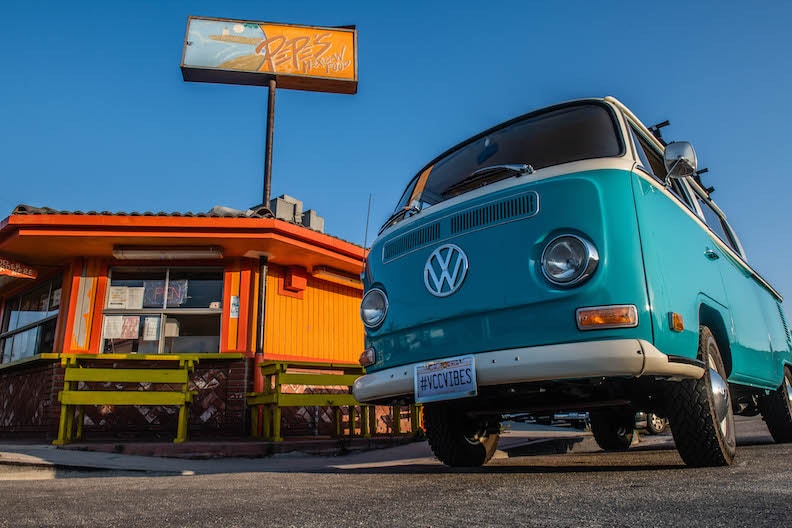
Oxnard tacos are large, flavorful and inexpensive both on and off the Taco Trail.
Now that you’re fueled up, you can stop to watch the pumped-up Dallas Cowboy at their training camp just down the road (check the schedule in advance); learn more about the history of the automobile (and early road tripping) at the Mullin Automotive Museum; or take in downtown’s Heritage Square where you’ll find California Victorian-era homes and office buildings surrounding a lush garden.
Channel Islands National Park
If you’ve never heard of the “Galapagos of North America,” that’s probably because you’ve never been to Channel Islands National Park. Take the one-hour, boat ride from the harbor in Oxnard for a day of exploring the history, nature and archeology of the park as well as for some recreation and exercise. The five islands comprising the national park are the sites of the oldest known human remains in North America. Once 148 Native American villages were located there. You can use your imagination to visualize the wooly mammoths that roamed there until the end of the Ice Age. The sixth island off the Southern California coast is Santa Catalina. Its population of 4,200 leaves nothing to the imagination.
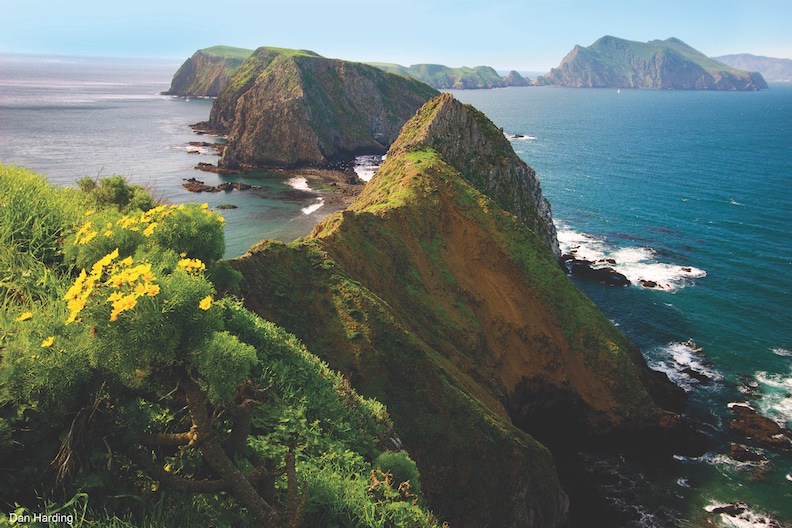
The company that takes visitors to the Channel Islands National Park from Oxnard and Ventura is called Island Packers. Those planning to camp overnight should take note and carry in everything they might require. There are no stores, restaurants or bars on the Channel Islands. Guard your food. The island foxes are timid but the circling ocean birds, deer mice and spotted skunks can be aggressive. Photo by Dan Harding
The great California outdoors beckons on your island visit with bird watching, whale watching (blues and humpbacks love it here), frolicking sea lions, island foxes, snorkeling, kayaking, diving (there are World War II shipwrecks) and hiking. You can also access the islands by ferry from Ventura Harbor a little further away.
Ventura
Conclude your adventure in Ventura. This surfy-retro wonderland will give you plenty of reasons to start humming that song again. It’s also the best place to buy souvenirs from your California sunshine road trip.
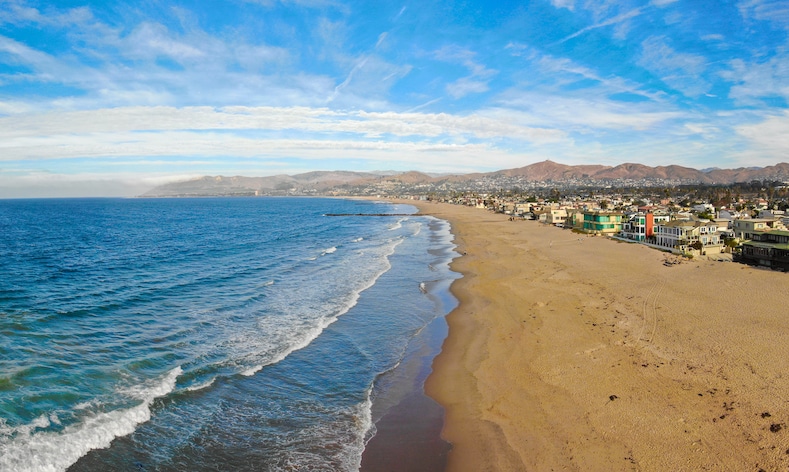
Ventura’s miles of sand and surf are the consummate finish to a trip on the Ventura County Coast. Take time to soak in the pleasures of the city’s summer-perfect attractions. And definitely try an ice cream in a fish-shaped cone.
Kids will love scampering on Ventura’s boardwalk fishing pier and enjoy the light-up swan and dragon pedal boats at Ventura Boat Rentals. Adults can check out Tina O’Brien’s prints and maritime art at the Mermaid Gallery. A must refreshment is the Instagrammable “fishzookie” at Coastal Cone, a sundae in kooky flavors on a hot fish-shaped pastry.
Get some well-deserved shuteye at kitschy Waypoint Ventura Vintage Trailer Hotel. More than just having a stay in a retro trailer, you’ll be steps from the beach for an early morning walk to finish your trip.
The Maine Coast
Ogunquit to Cape Elizabeth
Snowbirds from Canada, humidity-drenched New Yorkers and Bostonians, and politicians craving a secluded getaway have flocked to Maine’s southern coast since the late 19th-century. A gorgeous stretch of road following the state’s rocky shoreline and connecting storied towns like Ogunquit, Kennebunkport and Portland, the East Coast route has become a favorite for art lovers, hikers, foodies and the LGBTQ community.
There’s a reason why Maine is known as Vacationland. Where else could you eat lobster three times a day (think poached lobster for breakfast); adopt a new vocabulary saying “wicked, ”ayuh” and “Downeast Maine;” and actually enjoy dipping your toes into the icy-cold ocean? Maine has a free spirit, shaped by its rugged coastline and bitterly cold winters. It’s a state without pretension and the perfect place for a coastal road trip.
While the entire route covers only 43 miles, traffic will determine the time you spend on the road, anywhere from one hour to a vexing three hours. Plan to stop, refresh and experience instead of sitting in your car.
Ogunquit
Ogunquit has long been an art colony with museums and theater that draw crowds in the summer. From Boston, head north on I-93 and join I-95 towards Portsmouth, New Hampshire. You’ll eventually meet up with Route 1, a winding road passing through small towns before reaching the traffic snag that indicates you’ve arrived in Ogunquit.
To absorb the art-colony experience, stop at the Ogunquit Museum of American Art and take in a summer-stock performance at the Ogunquit Playhouse. Wander along gallery-filled Perkins Cove, indulging in an ice cream break (try the local peppermint stick) before setting off on a gorgeous walk called The Marginal Way.

Forget barbecue. Don’t even think about Mexican food. In Maine, you eat lobster. Lobster for breakfast, poached in a bowl with broth and some herbs. A lobster roll for lunch. And a hot-boiled lobster for dinner with melted butter for dipping meat extracted from the shell. Pure bounty from the sea with no mustard or ketchup necessary. Photos by Meryl Pearlstein.
The one-mile path hugs the coast’s craggy, bedrock cliffs with views and a soundtrack of crashing waves. Scenes like these inspired Winslow Homer to create his acclaimed series of seascapes. Along the sometimes-crowded route, you’ll encounter flowers, benches, and places for rock scrambling.
Continuing north, the expanse of Ogunquit Beach unfolds with a mix of stately homes and family-friendly lodgings. For a luxe stay, the redone Cliff House on Cape Neddick has ocean views and a spa to help you recover from the congestion you survived to get there.
Eating a lobster is a rite of passage in Maine, and you should hit up the Ogunquit Lobster Pound for an introductory dinner. Don’t be proud – put on the lobster bib. It will keep you clean even though I can’t say the same for your hands. The servers will gladly show you how to crack a lobster.
Kennebunk and Kennebunkport
The tony Kennebunks, with their stately mansions and Victorian homes, have roots in shipbuilding and seafaring. Today, the villages are known for their relaxed seaside vibe and former summer resident, the late President George H.W. Bush. Drive along Summer Street to view the 19th-century sea captain homes. Some have widow’s walks, attesting to the watch-and-wait lives of the wives. The yellow-and-white Wedding Cake House is one of the most photographed in the state.
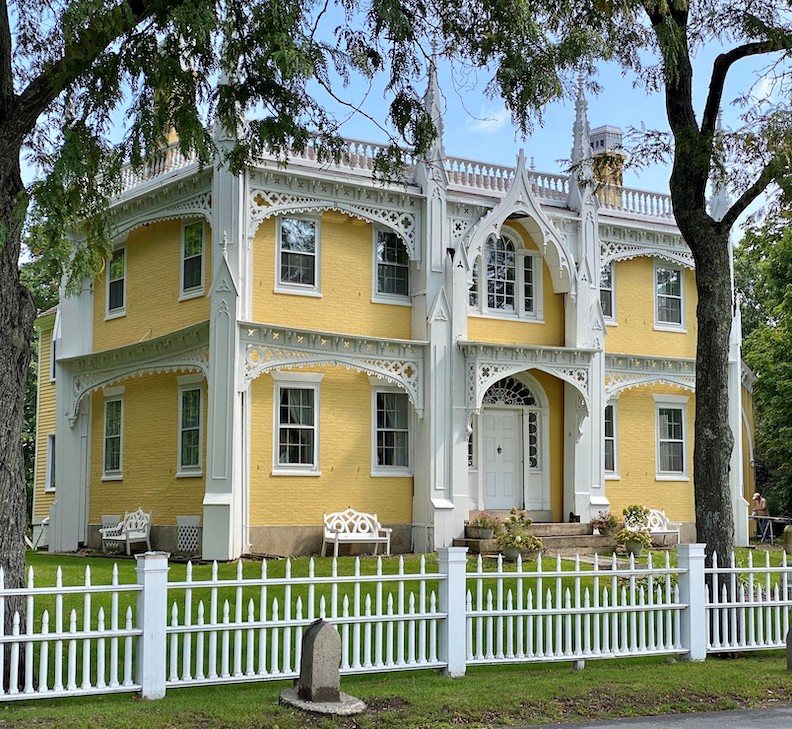
Kennebunkport’s wedding cake house is typical of the elegantly constructed 19th-century homes found in Maine. Photo by Meryl Pearlstein
Pass through Dock Square where you’ll spot queues at the famous Clam Shack. Nearby shops sell sea glass jewelry. Follow King’s Highway to Goose Rocks Beach, home of the lovely The Tides Beach Club, before heading to Ocean Avenue in the direction of the Bush estate. You’ll know when you’ve arrived – the US flag is on display and you might see security hovering.
Return to Route 1 and crawl your way 30 miles north to Portland. For a break from traffic, the Maine Classic Car Museum in Arundel has a fine collection of cars including favorite road trippers, Model T’s and woodies.
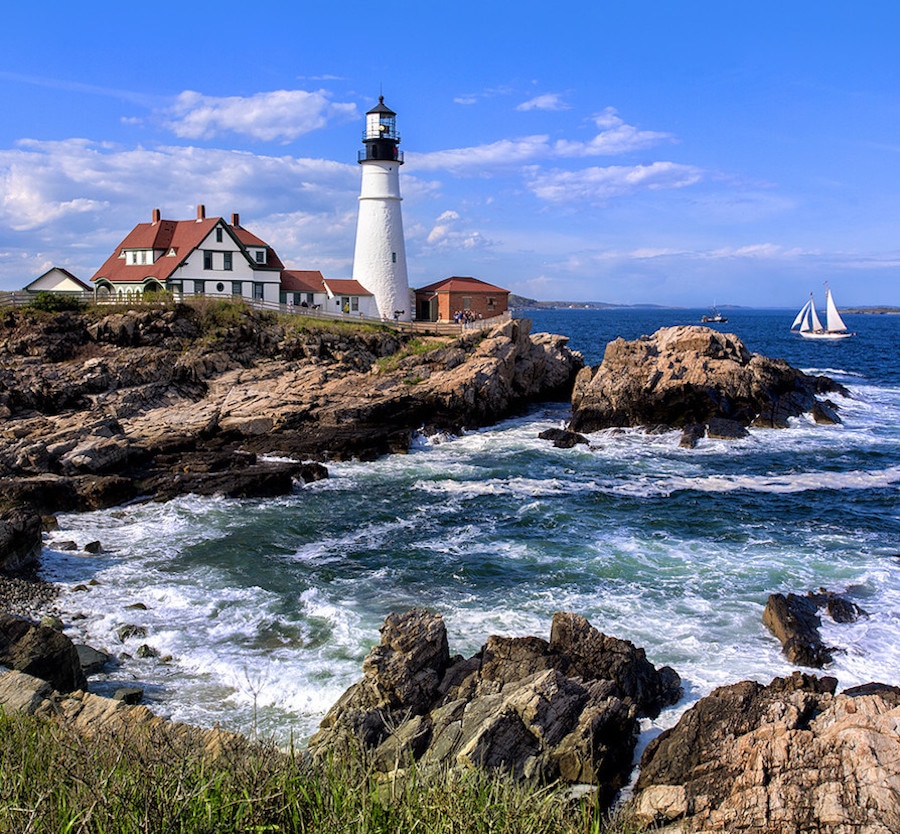
Lighthouses like this one outside Portland capture Maine’s maritime history and rugged coastline. Photo courtesy of Visit Maine.
Portland
A historic city built from maritime trade and manufacturing, attractive Portland sadly has a devilish parking situation. You’ll need to download apps to park in certain areas, and garages have incomprehensibly early closing times.
Once you do park, however, you’re in for a rich, taste of 19th-century New England, complete with cobblestoned streets, Victorian mansions and brick sidewalks.
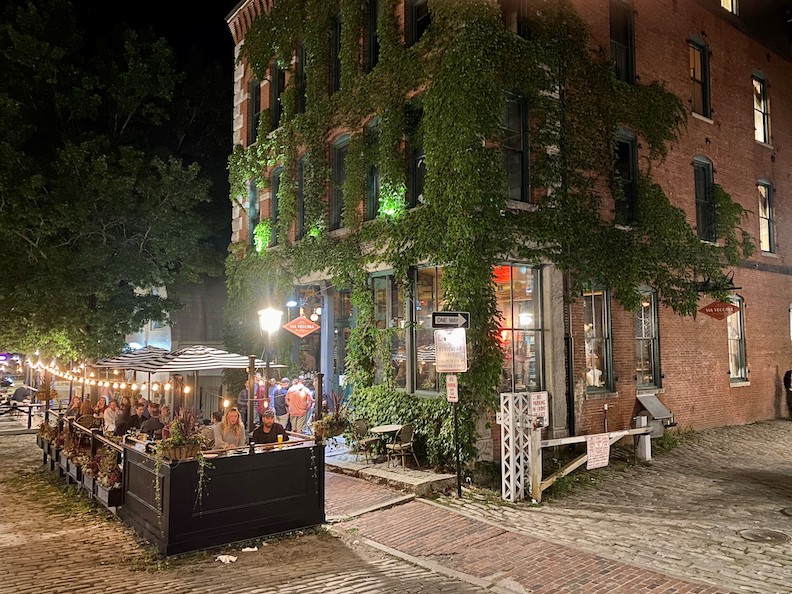
Portland, Maine has a population of 67.000, but its elegant, yet relaxed, restaurants compare favorably with larger New England cities. In Portland, some believe that it’s easier to find a great restaurant than a parking space. Photo by Meryl Pearlstein
The largest town in Maine, Portland is regaled as a foodie city with a network of artisanal breweries as well. Seafood-centric restaurants like Eventide Oyster Co. and DiMillos (on an actual ship) are busy at all times. Inventive spots like Fore Street, Central Provisions and Duckfat will happily ruin your diet.
For an art fix, the Portland Museum of Art has an important collection of paintings by international artists and those with Maine connections including Winslow Homer, Andrew Wyeth and Edward Hopper. The I.M. Pei-designed building sits just off the Old Port in the main shopping area.
A drive by the Eastern Promenade overlooking Casco Bay will give you a heady dose of sea air while the Western Promenade is lined with Victorian homes.
Cape Elizabeth
Instead of overnighting in busy Portland, drive 10 minutes to Cape Elizabeth where you’ll find one of the best resorts in the state, The Inn by the Sea. This pet-friendly resort has kid-friendly s’more-making and an endearing foster dog program.
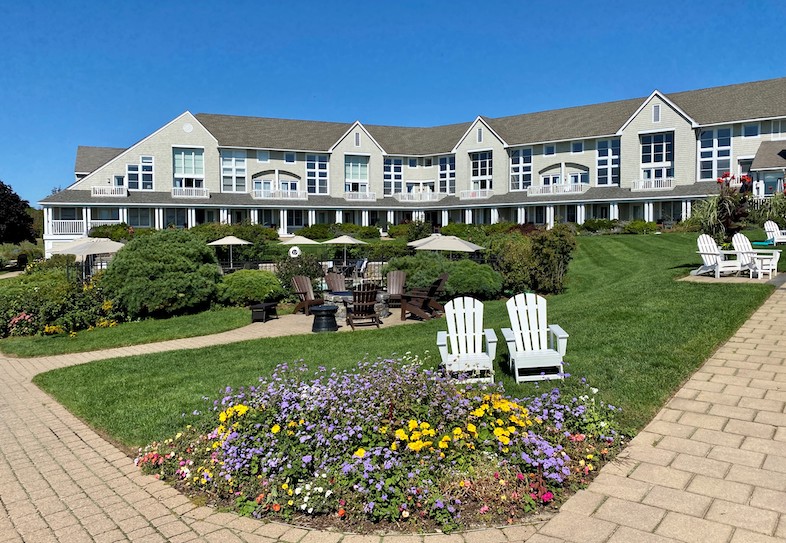
At the Inn by the Sea in Cape Elizabeth, guests take relaxation seriously. Photo by Meryl Pearlstein
A hilly drive leads to Two Lights State Park for a beautiful view of Maine’s iconic lighthouses and rocky coast. The adjacent Lobster Shack is well-known for its lobster rolls and Whoopie Pie.
The Loneliest Road in America
Nevada’s Highway 50
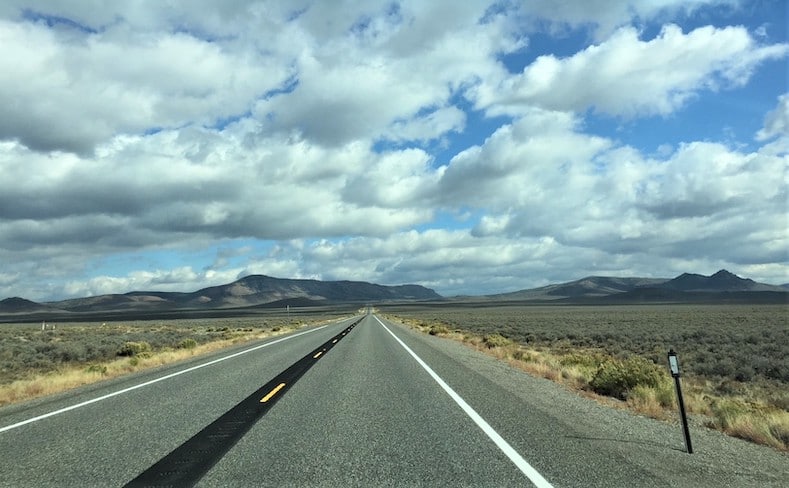
Like the view? This is pretty much what you’ll see for the next couple hours. Photo by Meryl Pearlstein
Called The Loneliest Road in America by Life magazine, Highway 50 delivers on its promise of solitude. If you’re concerned about being near crowds this trip ensures that you’ll spend more time by yourself than in the company of strangers. Highway 50 connects Carson City to Baker with five towns and a few detours in-between, and more sagebrush and sand than people.
The highway follows the route that Native Americans, miners, and the Pony Express blazed more than a century ago. The full length ranges from 375 to 500 miles, depending on how often you digress. Fill up your gas tank and buy some provisions to last you for maybe three days – it could be a while before you find refueling opportunities.
Fallon
Starting from Reno, head east to Fallon, driving 60 miles to this tiny mecca of everything Western.
Stop for a well-deserved break at Frey Ranch, a working ranch since 1918, and the home of Churchill Vineyards and Frey Distillery. There’s wine to sample, true, but you really deserve something stronger after the long, lonely drive: Frey’s rye and bourbon whiskey distilled from grains grown near Lake Tahoe.
To soak up all that Fallon goodness try the local hearts of gold cantaloupe jam and tuck into a Certified Angus steak in the Three Sisters Steakhouse at Stockman’s Casino. Then play a few hands to see if you can cover your “Dealer’s Choice” meal.
If you’ve never experienced a gunslinger competition, pause at Fallon’s Churchill County Fairgrounds to see the World Championship Cowboy Fast Draw with participants in full period attire.
You can recover from all this Western activity at Middlegate Station, originally a town saloon and rest stop on the Pony Express. The sign says is all: “Welcome to Middlegate. The middle of nowhere, population 17.” Pump your own gas, literally, with a real pump. Then grab a brew and look at the saloon ceiling covered with dollar bills. Banks didn’t exist when it opened so passing miners pinned cash overhead, autographed with their names for future use.
Austin
Turn on the radio and get comfortable for the next length of road is120 miles to Austin. Austin was born as a silver mining town, home to some of Nevada’s more colorful prospectors. You won’t see any miners today, but you will see other kinds of pioneers, outdoors-loving bikers and hikers taking advantage of the expansive Toiyabe Mountain Range. And maybe you’ll spot a ghost or two, particularly if you overnight at the Magnolia Gallery & Inn. It dates from 1864, the beginning of the mining rush.
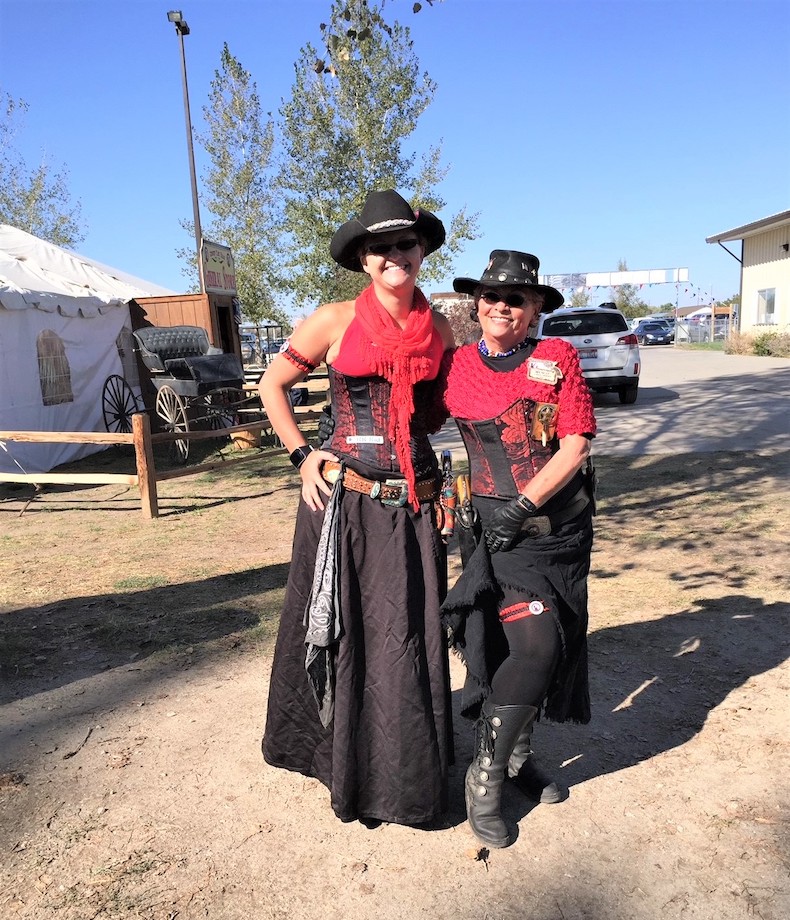
At the Churchill County Fairgrounds in Fallon, female gunslingers are fast with a pistol at the World Championship Cowboy Fast Draw competition. Photo by Meryl Pearlstein
Eureka
If you’re starting to crave the company of strangers, it’s a “Eureka!” moment when you reach “The Friendliest Town on the Loneliest Road.” Share some conversation and knock down a shot with the locals at Eureka’s down-home Owl Club saloon.
To explore the former glory days of this mining town, visit the 1879 Eureka Sentinel Newspaper Building, the home of The Eureka Sentinel Museum. Inside you’ll find a complete pressroom from the 1800s. Posters published by the newspaper and artifacts of the period give insight into the hardships of miners’ lives.
For your last dose of Eureka history stop by the 1880 Eureka Opera House. It hosted opera performances and New Year’s celebrations, as well as screened the town’s first silent movies. The stage curtain is a microcosm of history, plastered with ads for businesses of the times. American history fans take note: the building received the 1994 National Preservation Honor Award.
Ely
It’s a 90-minute solitary drive before you reach Ely, originally a stagecoach stop for the Pony Express and later the site of a copper strike.
The wealth of this mining city is still on display at the glitzy Hotel Nevada. Built in 1929, the landmark hotel and gambling hall retains its original design with an original neon miner sign in front.
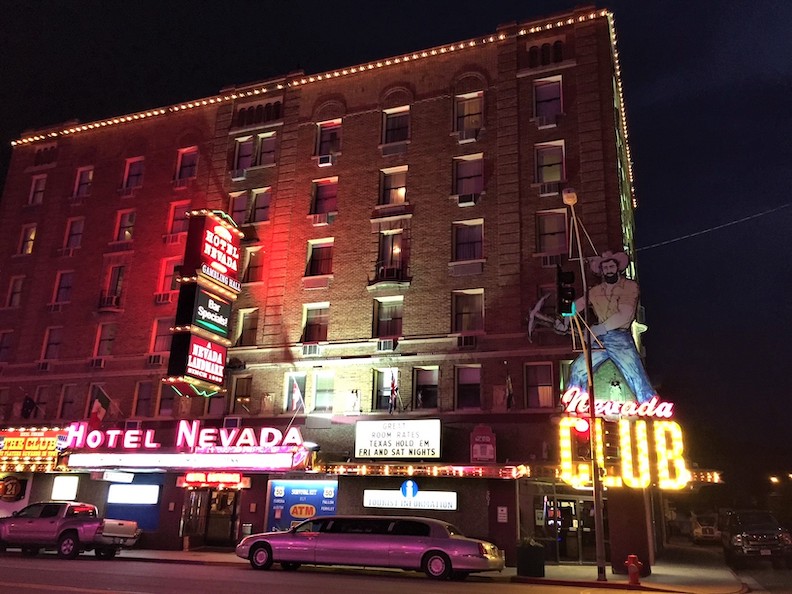
Guests today arrive in stretch limos instead of Pony Express horses, but the Hotel Nevada nevertheless manages to stay true to its frontier roots. Photo by Meryl Pearlstein
Feeling racy? The Big 4 Ranch, a short walk from the hotel, is Nevada’s oldest bar and legal brothel. You can have a drink at the bar, chat up the bartender, and perhaps catch a glimpse of what might be happening behind closed doors.
The Best Detour off Highway 50, Rachel
There’s one detour you must take if you have any curiosity about Area 51: Rachel, the UFO capital of the world. You’ll see signposts with photos of space aliens’ eerie bug-eye faces everywhere in this town of 54 hardy souls. Even the “Welcome to Rachel” sign has a UFO on it.
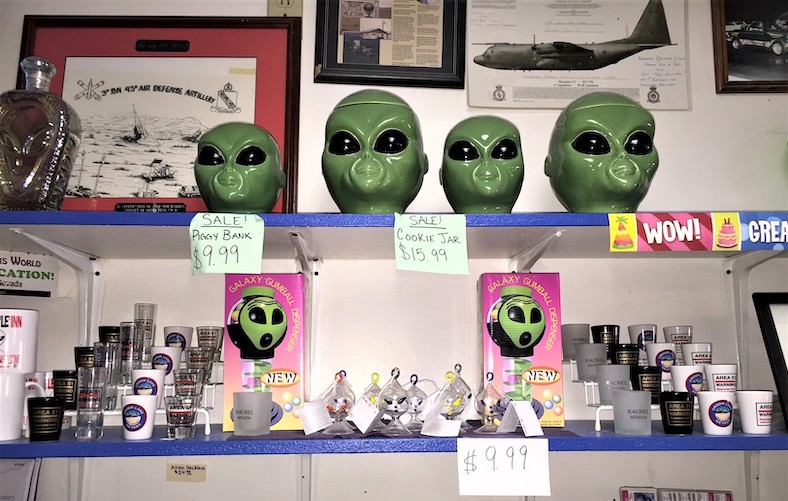
Some folks in Rachel, NV think that aliens live among us. The good news is that none, as yet, have asked for asylum or welfare. Photo by Meryl Pearlstein
Don’t miss Little A’Le’Inn on the appropriately named Extraterrestrial Highway. The kitschy restaurant-inn sells all kinds of alien-emblazoned souvenirs including a stuffed alien that could definitely cause nightmares.![]()
Originally from Boston, Meryl Pearlstein lives in New York where she writes about the cultural aspects of travel. She is the author of Fodor’s Family: New York City with Kids and a restaurant reviewer for Gayot.com. Follow her on social media @merylpearlstein.

